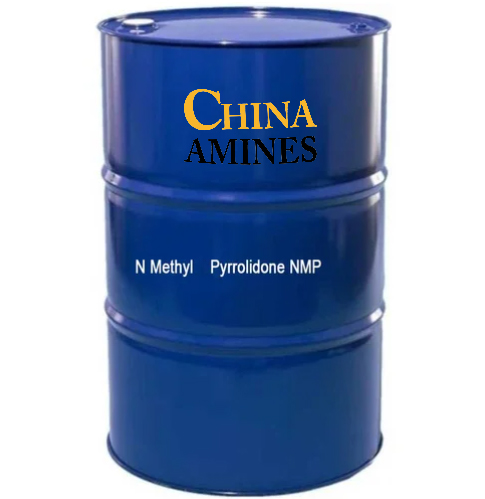1. Chemical Structure and Properties
Molecular Formula: C₅H₉NO
Structural Formula:
A five-membered lactam with a methyl group attached to the nitrogen atom.
Physical Properties:
Appearance: Clear, colorless to pale yellow liquid with a mild amine-like odor.
Boiling Point: 202°C; Density: 1.03 g/cm³; Vapor Pressure: 0.3 mmHg at 20°C.
Solubility: Miscible with water, alcohols, and most organic solvents.
Chemical Properties:
Polarity: High polarity (dielectric constant: 32.0) and strong solvency for resins, polymers, and metals.
Thermal Stability: Stable up to 250°C; decomposes above 350°C into toxic gases (CO, NOₓ).
Hygroscopicity: Absorbs moisture from air, forming a stable hydrate.
2. Industrial Applications
Electronics:
Photoresist Stripping: Removes hardened photoresist from silicon wafers in semiconductor manufacturing (e.g., TSMC’s 3nm node process).
Lithium-Ion Batteries: Solvent for electrode slurry coating (NMP content >80% in LiNiMnCoO₂ cathodes).
Pharmaceuticals:
Reaction Solvent: Facilitates API synthesis (e.g., atorvastatin) and crystallization.
Extraction Medium: Isolates natural compounds (e.g., taxol from yew bark).
Petrochemicals:
Gas Purification: Absorbs H₂S and CO₂ from natural gas streams.
Lubricant Additive: Enhances thermal stability of synthetic oils.
Polymers:
Polyurethane Production: Solvent for spandex fiber spinning.
3. Safety and Toxicology
Health Hazards:
Acute Exposure:
Skin Contact: Defatting action causes dermatitis (rabbit skin LD₅₀: 5,000 mg/kg).
Inhalation (≥10 ppm): Respiratory irritation, headaches (TLV-TWA: 10 ppm).
Ingestion: Moderately toxic (oral LD₅₀ rat: 3,000 mg/kg).
Chronic Effects:
Reproductive Toxicity: EU CLP classification Repro. 1B (H360D) for fetal harm.
Neurotoxicity: Animal studies suggest potential CNS effects at high doses.
Protection Measures:
PPE: Nitrile gloves, organic vapor respirators, chemical goggles.
Storage: Sealed containers in ventilated, cool areas away from oxidizers.
4. Environmental and Regulatory Compliance
Environmental Impact:
Aquatic Toxicity: LC₅₀ (fish, 96h): 50–100 mg/L; EC₅₀ (daphnia): 10–50 mg/L.
Biodegradability: Slow (OECD 301F: <20% in 28 days).
Persistence: Moderate bioaccumulation (log Kow: -0.5).
Regulatory Frameworks:
EU:
REACH: Restricted in consumer products (Annex XVII); workplace exposure limits enforced.
CLP: Classified Repro. 1B (H360D), Eye Irrit. 2 (H319).
USA:
OSHA PEL: 10 ppm (8-hour TWA); EPA: Listed on Toxic Release Inventory (TRI).
China:
GB 13690-2009: Classified as Hazardous Chemical (Class 6.1).
Waste Management:
Incineration with NOₓ scrubbers; wastewater treatment via activated carbon adsorption.
5. Case Studies and Application Insights
Case 1: Semiconductor Photoresist Stripping (Samsung, 2023):
Process: Replaced acetone with NMP-based strippers for EUV lithography residue removal.
Result: 30% faster stripping speed and 99.9% wafer surface purity.
Case 2: Lithium Battery Production (CATL, 2022):
Application: NMP recovery system achieved 95% solvent reuse in cathode coating.
Cost Savings: Reduced solvent costs by $1.2M annually per production line.
Comparative Analysis:
NMP vs. DMSO:
Pros: Lower toxicity (vs. DMSO’s skin penetration risk); higher thermal stability.
Cons: Stricter reproductive toxicity regulations limit NMP’s use in consumer goods.
Specifications:
N-Methyl Pyrrolidone (NMP) is a clear, colorless, water-miscible solvent (≥99.5% purity) with a boiling point of 202 °C, density 1.03 g/cm³, low heavy-metal content (<5 ppm), and excellent thermal and chemical stability for high-performance industrial formulations.


